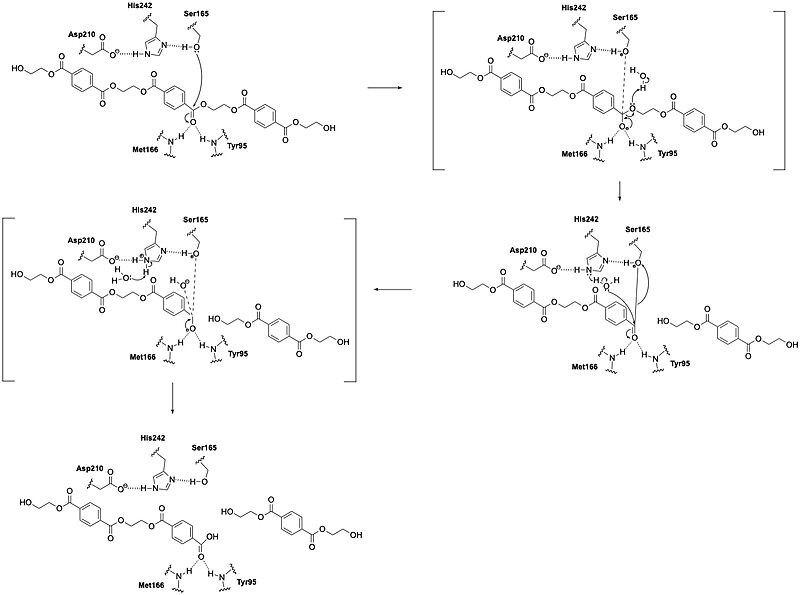Sandbox Reserved 1846
From Proteopedia
(Difference between revisions)
| Line 9: | Line 9: | ||
LCC catalyzes the hydrolysis of the [https://en.wikipedia.org/wiki/Ester ester] bonds in [https://en.wikipedia.org/wiki/Polymer polymers] of PET and breaks them down into their constituent monomers: terephthalic acid and ethylene glycol.<ref name="Tournier"/> The enzyme operates through a [https://en.wikipedia.org/wiki/Catalytic_triad catalytic triad] that consists of S165, D210, and H242. Using these residues, LCC can perform [https://en.wikipedia.org/wiki/Nucleophile nucleophilic attacks] on the carbonyl carbon atoms of the ester bonds in PET. During catalysis, the substrate binds in an elongated, predominantly [https://en.wikipedia.org/wiki/Hydrophobe hydrophobic] groove present in the enzyme's structure.<ref name="Sui"/> | LCC catalyzes the hydrolysis of the [https://en.wikipedia.org/wiki/Ester ester] bonds in [https://en.wikipedia.org/wiki/Polymer polymers] of PET and breaks them down into their constituent monomers: terephthalic acid and ethylene glycol.<ref name="Tournier"/> The enzyme operates through a [https://en.wikipedia.org/wiki/Catalytic_triad catalytic triad] that consists of S165, D210, and H242. Using these residues, LCC can perform [https://en.wikipedia.org/wiki/Nucleophile nucleophilic attacks] on the carbonyl carbon atoms of the ester bonds in PET. During catalysis, the substrate binds in an elongated, predominantly [https://en.wikipedia.org/wiki/Hydrophobe hydrophobic] groove present in the enzyme's structure.<ref name="Sui"/> | ||
| - | LCC functions best at elevated temperatures (around 65–72°C), which approaches the [https://en.wikipedia.org/wiki/Glass_transition glass transition] temperature of PET.<ref name="Zhang">PMID:40028137</ref> This temperature range maximizes PET chain mobility and makes the polymer more accessible to enzymatic action.<ref name="Khairul"/> The enzyme is | + | LCC functions best at elevated temperatures (around 65–72°C), which approaches the [https://en.wikipedia.org/wiki/Glass_transition glass transition] temperature of PET.<ref name="Zhang">PMID:40028137</ref> This temperature range maximizes PET chain mobility and makes the polymer more accessible to enzymatic action.<ref name="Khairul"/> The enzyme is extremely [https://en.wikipedia.org/wiki/Thermostability thermostable] compared to other PET hydrolases, with a [https://en.wikipedia.org/wiki/Melting_point melting temperature] of 84.7°C. This property allows it to remain functional under these high-temperature conditions.<ref name="Burgin"/> Also unlike other PET hydrolases such as Is-PETase, BTA1, BTA2, and FsC, LCC has substantially higher catalytic efficiency.<ref name="Yoshida">PMID:26965627</ref> Specifically, LCC has an initial PET-specific depolymerization rate of 93.2 mg TAeq·h⁻¹·mg⁻¹ enzyme at 65°C with [https://en.wikipedia.org/wiki/Amorphous_solid amorphous] PET. This means that it is at least 33 times more efficient than other tested enzymes.<ref name="Tournier"/><ref name="Khairul"/> LCC's function is limited by PET [https://en.wikipedia.org/wiki/Crystallization_of_polymers crystallinity], as the enzyme can more effectively hydrolyze amorphous regions of the polymer. As PET crystallinity increases during the depolymerization reaction (due to exposure to elevated temperatures), the enzyme's efficiency decreases. This limits complete depolymerization unless optimal conditions and enzyme variants are used.<ref name="Sui"/><ref name="Zhang"/> |
== Relevance == | == Relevance == | ||
Revision as of 20:31, 14 April 2025
| This Sandbox is Reserved from March 18 through September 1, 2025 for use in the course CH462 Biochemistry II taught by R. Jeremy Johnson and Mark Macbeth at the Butler University, Indianapolis, USA. This reservation includes Sandbox Reserved 1828 through Sandbox Reserved 1846. |
To get started:
More help: Help:Editing |
Leaf Branch Compost Cutinase
| |||||||||||
References
- ↑ 1.0 1.1 1.2 1.3 Tournier V, Topham CM, Gilles A, David B, Folgoas C, Moya-Leclair E, Kamionka E, Desrousseaux ML, Texier H, Gavalda S, Cot M, Guemard E, Dalibey M, Nomme J, Cioci G, Barbe S, Chateau M, Andre I, Duquesne S, Marty A. An engineered PET depolymerase to break down and recycle plastic bottles. Nature. 2020 Apr;580(7802):216-219. doi: 10.1038/s41586-020-2149-4. Epub 2020 Apr, 8. PMID:32269349 doi:http://dx.doi.org/10.1038/s41586-020-2149-4
- ↑ 2.0 2.1 2.2 2.3 2.4 Sui B, Wang T, Fang J, Hou Z, Shu T, Lu Z, Liu F, Zhu Y. Recent advances in the biodegradation of polyethylene terephthalate with cutinase-like enzymes. Front Microbiol. 2023 Oct 2;14:1265139. PMID:37849919 doi:10.3389/fmicb.2023.1265139
- ↑ Ueda H, Tabata J, Seshime Y, Masaki K, Sameshima-Yamashita Y, Kitamoto H. Cutinase-like biodegradable plastic-degrading enzymes from phylloplane yeasts have cutinase activity. Biosci Biotechnol Biochem. 2021 Jul 23;85(8):1890-1898. PMID:34160605 doi:10.1093/bbb/zbab113
- ↑ Kolattukudy PE. Biopolyester membranes of plants: cutin and suberin. Science. 1980 May 30;208(4447):990-1000. PMID:17779010 doi:10.1126/science.208.4447.990
- ↑ 5.0 5.1 5.2 5.3 5.4 Khairul Anuar NFS, Huyop F, Ur-Rehman G, Abdullah F, Normi YM, Sabullah MK, Abdul Wahab R. An Overview into Polyethylene Terephthalate (PET) Hydrolases and Efforts in Tailoring Enzymes for Improved Plastic Degradation. Int J Mol Sci. 2022 Oct 20;23(20):12644. PMID:36293501 doi:10.3390/ijms232012644
- ↑ 6.0 6.1 Burgin T, Pollard BC, Knott BC, Mayes HB, Crowley MF, McGeehan JE, Beckham GT, Woodcock HL. The reaction mechanism of the Ideonella sakaiensis PETase enzyme. Commun Chem. 2024 Mar 27;7(1):65. PMID:38538850 doi:10.1038/s42004-024-01154-x
- ↑ 7.0 7.1 Stevensen J, Janatunaim RZ, Ratnaputri AH, Aldafa SH, Rudjito RR, Saputro DH, Suhandono S, Putri RM, Aditama R, Fibriani A. Thermostability and Activity Improvements of PETase from Ideonella sakaiensis. ACS Omega. 2025 Feb 12;10(7):6385-6395. PMID:40028137 doi:10.1021/acsomega.4c05142
- ↑ Yoshida S, Hiraga K, Takehana T, Taniguchi I, Yamaji H, Maeda Y, Toyohara K, Miyamoto K, Kimura Y, Oda K. A bacterium that degrades and assimilates poly(ethylene terephthalate). Science. 2016 Mar 11;351(6278):1196-9. doi: 10.1126/science.aad6359. PMID:26965627 doi:http://dx.doi.org/10.1126/science.aad6359
- ↑ Landrigan PJ, Stegeman JJ, Fleming LE, Allemand D, Anderson DM, Backer LC, Brucker-Davis F, Chevalier N, Corra L, Czerucka D, Bottein MD, Demeneix B, Depledge M, Deheyn DD, Dorman CJ, Fénichel P, Fisher S, Gaill F, Galgani F, Gaze WH, Giuliano L, Grandjean P, Hahn ME, Hamdoun A, Hess P, Judson B, Laborde A, McGlade J, Mu J, Mustapha A, Neira M, Noble RT, Pedrotti ML, Reddy C, Rocklöv J, Scharler UM, Shanmugam H, Taghian G, van de Water JAJM, Vezzulli L, Weihe P, Zeka A, Raps H, Rampal P. Human Health and Ocean Pollution. Ann Glob Health. 2020 Dec 3;86(1):151. PMID:33354517 doi:10.5334/aogh.2831
- ↑ Jambeck JR, Geyer R, Wilcox C, Siegler TR, Perryman M, Andrady A, Narayan R, Law KL. Marine pollution. Plastic waste inputs from land into the ocean. Science. 2015 Feb 13;347(6223):768-71. PMID:25678662 doi:10.1126/science.1260352
Student Contributors
Ashley Callaghan Rebecca Hoff Simone McCowan


